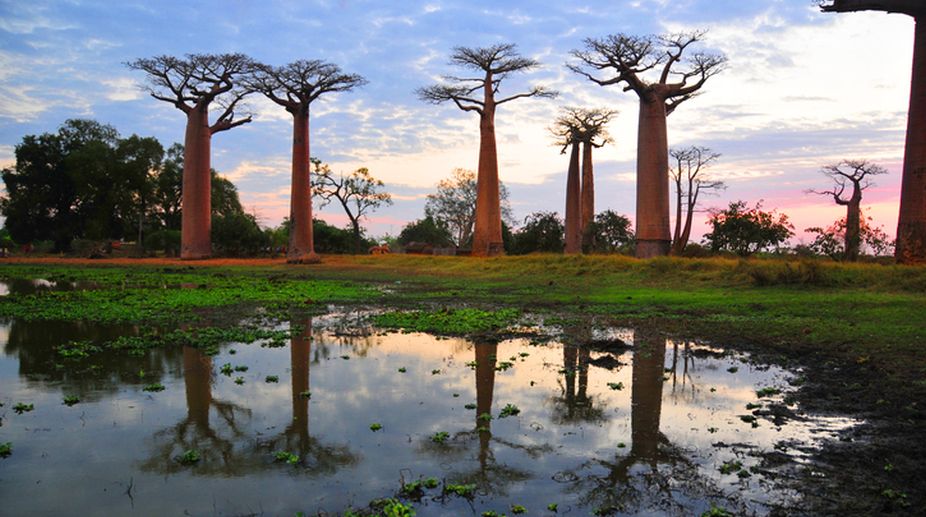Seven Somali nationals found dead in boat accidents north of Madagascar
Seven people were found dead when a drifting boat carrying Somali nationals was discovered at sea and brought to the island of Nosy Be off the northwestern coast of Madagascar

Alley of the Baobabs, Madagascar (Photo: Getty Images)
In an effort to highlight places of interest in countries across the world, their varied culture, economy and history, The Statesman brings to you a Weekly Focus on countries with which India shares diplomatic ties and friendship. This week’s focus is on Madagascar. Know all about the country.
Capital: Antananarivo, Currency: Malagasy ariary, Language: French (official), Malagasy (official), English. Religion: Christian, indigenous, Muslim Ethnic groups: Malayo-Indonesian (Merina and related Betsileo),
Cotiers (mixed African, Malayo-Indonesian, and Arab ancestry – Betsimisaraka, Tsimihety, Antaisaka, Sakalava), French, Indian, Creole, Comoran.
Advertisement
CLIMATE
Advertisement
The mountains, including Antananarivo, are dry, cool and windy during September to December, shifting to warm and thundery from November to April. Dry season runs from April to October. Travelling to Madagascar between January and March is ill-advised due to extreme storms and occasional cyclones. From December to March. the rainforests in the eastern and northern parts of the country are battered by tropical storms brought on by cyclone season, and temperatures tend to hover around 30ºC . Despite being rainy season up north, during this period, the central parts will be a lot drier and cooler, with temperatures around 25ºC. The southern and western coasts are the driest parts of the country.
90 WEEKLY FLIGHTS
More than 90 weekly connecting flights from New Delhi to Ivato airport are available. The major airlines flying on this route are Air Seychelles, Jet Airways, Etihad Airways, Emirates, and Air India. Nearly 70 flights operate from Mumbai to Madagascar, every week. Mumbai, Mahe Island, Mauritius, Dubai and Abu Dhabi are the major layover airports.
INFLUENTIAL DIASPORA
There are about 22,000 persons of India origin in Madagascar, including approximately 2,500 Indian passport holders. Some of the Indian diaspora are quite influential and their contribution to the total GDP of Madagascar is substantial. Most Indians are in trading but some are also in manufacturing and other businesses as well. In recent years, a number of Indian professionals have been working in multinational companies in Madagascar.
Street snacks aplenty
Street snacks to watch out for include slices of coconut and peanuts in a sweet coconut or toffee coating. If you spot a man carrying a glass case on his head, he is probably selling koba (banana, peanuts and rice, ground to a paste, wrapped in a banana leaf and served in slices),sambos(samosas) or nems (spring rolls). On the coast, seafood naturally predominates, including all manner of fish, as well as lobster and shellfish. Pizza is popular too.
Indian investments rising
The main items of exports from Madagascar to India are coffee, spices, edible vegetables, salt, sulphur and earth, essential oils and resinoids, base metals, precious and semi-precious stones. The major imports from India are cereals, apparel, iron & steel, cotton, pharmaceutical products, products of the milling industry, sugar and sugar confectionery.
Following the installation of popularly elected government and subsequent international recognition, the Indian companies are showing renewed interest in investing in Madagascar. Major Indian investments amounting to approximately $907.4 million by Indian companies were in the mining, oil and gas sectors, telecom sector and health sectors. Airtel is the main player in mobile telephony and Dr Aggarwal’s Eye Hospital in the health sector. Others who have invested in Madagascar but are yet to commence operations include the Tatas, Essar, Varun Industries, GIMPEX Osho Ventures, Sahara (India), Diamond Cement and Jindals. Madagascar has vast mining potential in oil and gas.
NATURAL WONDERS
Ile Sainte Marie: It was the major centre of piracy due to its lagoons and vegetations that hinder navigation. Diving, fishing, surfing and whale watching are the famous aquatic activities.
Ranomafana: Famous for its dozen species of lemurs, Ranomafana National Park is a rainforest that is spread over more than 41,000 hectares of land. It is in the southeastern part of the country and is rich in biodiversity. In 1991, it was given the status of National Park to limit human interference.
Tsingy De Bemaraha: In 1990, Unesco included Tsingy de Bemaraha in the list of World Heritage Sites due to its mangrove forests, specific wildlife population and unique karst limestone rock formation. The southern side is a National Park that is open to people while the northern part is a strictly cosseted natural reserve.
Compiled by Kunal Jain (kunaljain@thestatesman.com)
Advertisement